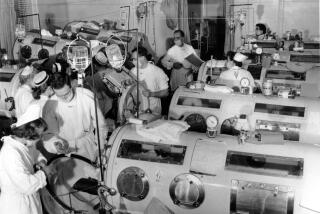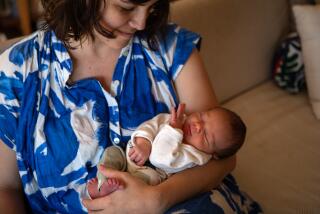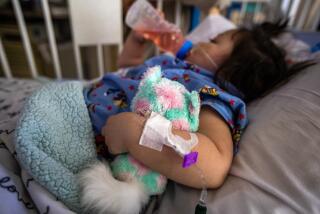Poorest Children Last in Line for Vaccine
UNITED NATIONS — It can kill a baby in a day, causing such swift, severe dehydration that the infant cannot even produce the tears to cry.
Rotaviral diarrhea is the world’s second leading killer of children 5 and younger, trailing only pneumonia. Not to be confused with the ailment that strikes travelers abroad, it is a virus that infects virtually every child on Earth. It’s spread as simply as a tiny hand touching a dirty diaper, then a mouth or bottle nipple.
“There’s not an individual alive who doesn’t get infected by the age of 5, in the poorest countries and the richest,” said Dr. Albert Kapikian of the National Institutes of Health. “But the consequences are very different, depending on which part of the world you live in.”
In wealthy countries, drinking lots of fresh water can quickly restore a well-nourished child to health. In severe cases, intravenous drips are readily available. Although there are 500,000 cases of rotavirus reported annually in the United States, there are only a few dozen deaths.
But in developing countries with malnutrition and limited health care, 800,000 to a million children die of the disease each year.
There is hope that the deadly virus can be eliminated. A new vaccine that prevents the worst forms of the disease has been licensed in the U.S.
But at $114 per treatment, Rota-Shield, as it is called, is part of the leading edge of a new era of vaccines that may not reach the world’s poorest children for decades, if at all.
Vaccines are by far the cheapest, most effective health care available, but with more than 1.4 billion people living on less than a dollar a day per person, the new ones will simply be out of reach for many.
“We are on the brink of an explosion of new vaccine products,” two analysts concluded in a recent paper for the World Health Organization. “The challenge facing the international community is to facilitate access.”
“The bottleneck is global,” said Jacques Martin, a leading pharmaceutical company executive and outspoken vaccine advocate. “We’re very quickly arriving at a time when children in the U.S. and Europe will receive 15 vaccines and children in the rest of the world will receive maybe five or six. We need to decide if we’re going to accept that evolution, which should be unacceptable, or do something about it now.”
Martin says, and others grudgingly agree, that the answer is not to be found in vaccine companies’ pockets.
“The estimates for development of a single new vaccine are in the range of $100 million to a couple of hundred million dollars. And industry has to recoup that,” said Dr. Jim Wenger with the expanded program for immunization at WHO in Geneva.
Some public health officials say it has always taken decades for a new vaccine to “mature” in industrialized countries--where upfront costs are paid off via higher-priced sales--and then slowly move to poorer countries as prices go down.
“If we could distribute this [RotaShield] in the next 10 to 12 years, we would be doing a huge favor to the world,” said Dr. Roger Glass of the federal Centers for Disease Control and Prevention in Atlanta.
But others say that kind of time gap is unacceptable.
“A 10- or 15-year delay is not conscionable,” said Scott Wittet, spokesman for Programs for Appropriate Technologies in Health, a Seattle-based international public health group. “This is a basic right of every child to get these vaccines.”
There are efforts underway, and the rotaviral vaccine may be a success story yet. In December, the Bill and Melinda Gates Foundation pumped $100 million into the search for solutions; creative financing mechanisms are being studied by the World Bank and U.N. agencies; and new partnerships are being set up between big business and world health organizations. All this could shave at least a decade off the wait.
In the meantime, every year that passes, a quarter of a million children die from the virus in India alone.
Treatment Took Years to Develop
Like other deadly childhood diseases, rotavirus has a lengthy history of researchers devoting their lives to finding a remedy for it. In 1973, Australian researchers isolated the virus and christened it “rotavirus,” because it looked like a tiny rotating wheel.
For the next 25 years, Kapikian and a crew at the National Institute of Allergy and Infectious Diseases labored over possible vaccines, finally developing a successful one from rhesus monkey serum. When the Food and Drug Administration awarded the exclusive license Aug. 31 for RotaShield to Wyeth Lederle Vaccines, it was a moment of sweet triumph for Kapikian.
The inventor and his team endowed the vaccine with important gifts. They made it oral, far easier and kinder to administer to a young child than a shot, and more cost-effective and sanitary than needles. It is also freeze-dried, a boon for poorer tropical countries ill-equipped for refrigerated transportation and delivery.
Just nine months after FDA approval, RotaShield is on the lists of vaccines recommended by the American Medical Assn. and pediatric societies, and it is rapidly being introduced in clinics and doctors’ offices nationwide. Requests for approval have been submitted in Europe.
As for the rest of the world, Wyeth Lederle spokesman Doug Petkus said that “it is a goal of our vaccine company to make it available to the broadest population base. . . . I think the issue is how can we try to make it more widely available but on the other hand keep some semblance of a margin, some profit.”
But he could not say when the vaccine would be available in India, for instance.
Viral Strains Differ Around World
So what takes so long?
First comes the need for clinical trials. What prevents one strain of rotavirus in Boston may not prevent a related strain in Bangladesh. The only way to know is to first test small groups of children, then wider populations, in trials that can take two to four years.
RotaShield tests are beginning in China, Bangladesh, India, Guinea Bissau, Brazil and Malawi, funded by U.N. member nations, the Gates Foundation and industry.
Already, there are indications that the vaccine will not prevent several strains of the disease in India. Three other companies are working on comparable products that may work better and could drive down prices. But those too will require clinical trials.
Once successful trials are completed, country-by-country studies must be done on how heavily the disease affects children--and how much money could be saved by introducing the vaccine.
The studies are used to persuade layers of government to obtain funding for the new vaccine, through budget legislation or by applying for international aid. The timeline in this area is wide open.
Once that money finally is available, and the price of development paid off, manufacturers begin to build plants capable of producing the hundreds of millions of doses needed for global high-volume, low-cost markets.
Finally, clinic workers need training on how to administer the vaccine in often remote areas where fears of medication can run high--for example, they need to know that a child who takes RotaShield may develop a fever but that it will cause no long-term harm.
In an attempt to shorten that lengthy time frame, officials from U.N. agencies, industry, public health organizations and the World Bank have been meeting and talking regularly by telephone. In April, the Rockefeller Foundation sponsored a conference in Bellagio, Italy, to focus on how to deliver vaccines faster. Another is set for July in Seattle.
There is talk of parallel testing, of doing clinical trials and national studies at the same time. There is discussion of using public health funds to finance at least one factory.
Cyril de Quadro, director of the Pan American Health Organization in Washington, thinks the 130 million babies born each year are a potentially huge market that affords excellent opportunities to bargain for reduced prices, as long as global finances can be pooled to provide capital. He has proposed creation of a $5-billion to $10-billion global trust fund to ensure the availability of money for clinical trials, disease burden studies, education and purchases.
Other, smaller-scale ideas are also being advanced.
Amie Batson, at the World Bank, said the lending institution is planning to add considerable amounts of money to the $110 million worth of loans it has dedicated to immunizations since 1990. (Its total budget for all programs last year was $28.6 billion.)
In addition to providing more “very soft” long-term loans to poor countries, all World Bank officers handling health loans will aggressively educate ministers of finance and planning about the cost-effectiveness of vaccines as part of loan negotiations.
Judy Polsky, UNICEF’s senior immunization officer, said talks are underway about pricing publicly provided vaccines differently than in the past. UNICEF, the single largest purchaser of vaccines worldwide, holds biannual bids for vaccines and distributes them to scores of less wealthy countries.
But a middle band of “emerging” countries that could afford to pay more for vaccines has been identified. In exchange for agreements by manufacturers to slash prices of vaccines even further so that the poorest countries have a better shot at buying them, UNICEF would agree not to provide the vaccines to the middle band of countries.
Some people favor the idea, but others do not, said Wenger, the WHO immunization program official. “You’re basically lining up countries and deciding who is going to get vaccines and who isn’t,” he said.
Recognizing donor nation fatigue, UNICEF and WHO have also urged countries to pay their own way. Polsky said 43% of the very poorest countries now contribute to the purchase of vaccines.
Many See Need for a Galvanizing Leader
Amid all the creative ideas, many say what is missing is a galvanizing, highly visible leader.
“You need someone who can really open doors, who can get access to ministers of health, to heads of state and to industry captains. But you need someone who is also respected in the public health arena, who can figure out how to keep everybody moving,” said Lincoln Chen, senior vice president of the Rockefeller Foundation.
Some speak wistfully of the late Jim Grant, the UNICEF director who made immunizing the world’s children his top priority.
In 1980, only 5% of all children were immunized against the “Big Six”--polio, measles, smallpox, tetanus, diphtheria and whooping cough--even though some of the vaccines had been available for 30 years. By 1990, partly as a result of his unrelenting advocacy, prices for the six vaccines had dropped to a combined cost of $1, and 80% of the world’s children were being immunized.
In some Central African and Asian countries now, though, immunization rates have slipped below 50%.
Martin, head of the French subsidiary of vaccine producer Biocine Chiron and longtime head of vaccine advocacy for the International Pharmaceutical Manufacturers Assn., said, “Just the way a vaccine needs a booster dose sometimes, immunization programs need a booster dose too.”
(BEGIN TEXT OF INFOBOX / INFOGRAPHIC)
Rotavirus Facts
Rotavirus infects the intstine, causing diarrheal illness. It is the most common viral cause of diarrhea in young children. Most susceptible are those 6 months to 12 years old.
Annual Totals
* Worldwide
130 million childhood cases
18 million moderate to severe cases
800,000 to 1 million deaths
* United States
500,000 childhood cases reported
55,000-100,000 moderate to severe cases
20-100 deaths
Treatment
* Oral and/or intraveneous rehydration to replace fluids and salts lost through diarrhea, vomiting and perspiration. Dehydration is the most common cause of death among rotavirus victims.
* Antibotics do not work against rotavirus and are contraindicated.
Symptoms
* Diarrhea
* Vomiting
* Fever
* Dehydration
Transmission
Oral contact with fecal material
Prevention
Wash hands with soap after changing diapers and before preparing or eating food.
The Vaccine
* Name: Rotashield
* Manufacturer: Wyeth Lederle Vaccines
* FDA approval: Aug. 31, 1998
* Method of use: 3 oral doses at 2,4 and 6 months of age
* Cost: $38 per dose
* Side effects: Mild or moderate fever, irritability, decreased appetite or activity
* Effectiveness: Study of more than 2,000 children in Venezuela showed 88% reduction in cases of severe diarrheal illness.
Sources: National Institute of Allergy and Infectious Diseases; Bill and Melinda Gates Children’s Vaccine Program; Boulder County Health Department; Times staff reports.
More to Read
Sign up for Essential California
The most important California stories and recommendations in your inbox every morning.
You may occasionally receive promotional content from the Los Angeles Times.










